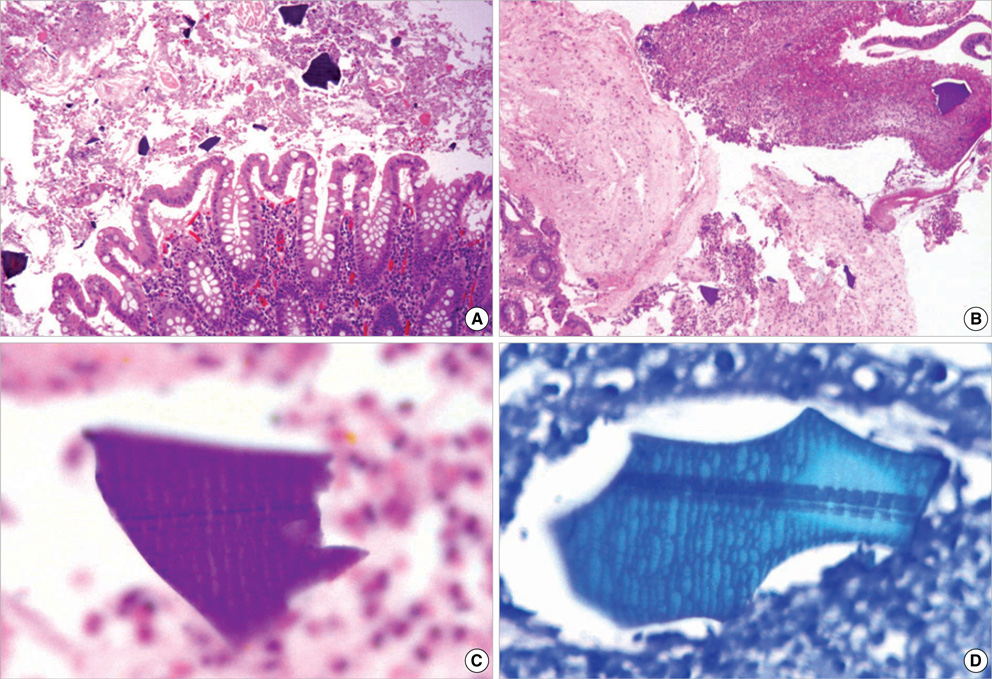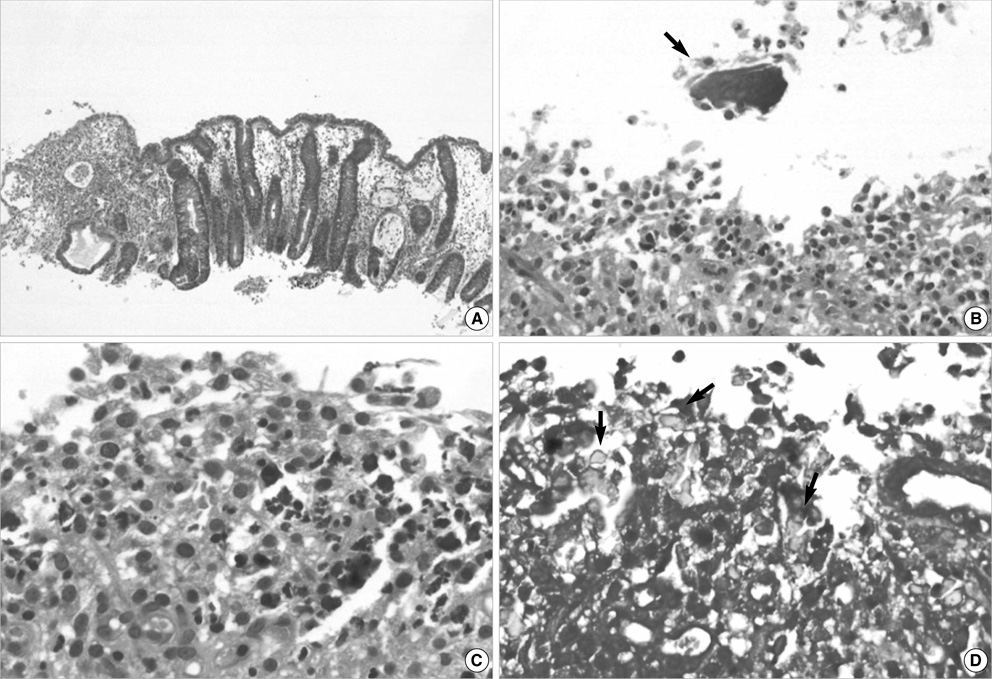J Korean Med Sci.
2009 Dec;24(6):1207-1211. 10.3346/jkms.2009.24.6.1207.
Colonic Mucosal Necrosis Following Administration of Calcium Polystryrene Sulfonate (Kalimate) in a Uremic Patient
- Affiliations
-
- 1Department of Pathology, Inje University Ilsan Paik Hospital, Ilsan, Korea. mjoo@paik.ac.kr
- 2Department of Gastrointestinal Division of Internal Medicine, Inje University Ilsan Paik Hospital, Ilsan, Korea.
- 3Department of Neurosugery, Inje University Ilsan Paik Hospital, Ilsan, Korea.
- KMID: 1783158
- DOI: http://doi.org/10.3346/jkms.2009.24.6.1207
Abstract
- Colonic necrosis is known as a rare complication following the administration of Kayexalate (sodium polystryrene sulfonate) in sorbitol. We report a rare case of colonic mucosal necrosis following Kalimate (calcium polystryrene sulfonate), an analogue of Kayexalate without sorbitol in a 34-yr-old man. He had a history of hypertension and uremia. During the management of intracranial hemorrhage, hyperkalemia developed. Kalimate was administered orally and as an enema suspended in 20% dextrose water to treat hyperkalemia. Two days after administration of Kalimate enema, he had profuse hematochezia, and a sigmoidoscopy showed diffuse colonic mucosal necrosis in the rectum and sigmoid colon. Microscopic examination of random colonic biopsies by two consecutive sigmoidoscopies revealed angulated crystals with a characteristic crystalline mosaic pattern on the ulcerated mucosa, which were consistent with Kayexalate crystals. Hematochezia subsided with conservative treatment after a discontinuance of Kalimate administration.
Keyword
MeSH Terms
Figure
Cited by 1 articles
-
Pharmacologic Treatment of Chronic Hyperkalemia in Patients with Chronic Kidney Disease
Gheun-Ho Kim
Electrolyte Blood Press. 2019;17(1):1-6. doi: 10.5049/EBP.2019.17.1.1.
Reference
-
1. Lillemoe KD, Romolo JL, Hamilton SR, Pennington LR, Burdick JF, Williams GM. Intestinal necrosis due to sodium polystyrene (Kayexalate) in sorbitol enemas: clinical and experimental support for the hypothesis. Surgery. 1987. 101:267–272.2. Rashid A, Hamilton S. Necrosis of the gastrointestinal tract in uremic patients as a result of sodium polystyrene sulfonate (Kayexalate) in sorbitol: an underrecognized condition. Am J Surg Pathol. 1997. 21:60–69.3. Kelsey PB, Chen S, Lauwers GY. Case records of the Massachusetts General Hospital. Weekly clinicopathological exercises. Case 37-2003. A 79-year-old man with coronary artery disease, peripheral vascular disease, end-stage renal disease, and abdominal pain and distention. N Engl J Med. 2003. 349:2147–2155.4. Rogers FB, Li SC. Acute colonic necrosis associated with Sodium polystyrene sulfonate (Kayexalate) enemas in a critically ill patient: Case report and review of literature. J Trauma. 2001. 51:395–397.5. Scott TR, Graham SM, Schweitzer EJ, Bartlett ST. Colonic necrosis following sodium polystyrene sulfonate (Kayexalate)-sorbitol enema in a renal transplant patient. Report of a case and review of the literature. Dis Colon Rectum. 1993. 36:607–609.6. Abraham SC, Bhagavan BS, Lee LA, Rashid A, Wu TT. Upper gastrointestinal tract injury in patients receiving kayexalate (sodium polystyrene sulfonate) in sorbitol: clinical, endoscopic, and histopathologic findings. Am J Surg Pathol. 2001. 25:637–644.7. Cheng ES, Stringer KM, Pegg SP. Colonic necrosis and perforation following oral sodium polystyrene sulfonate (Resonium A/Kayexalate) in a burn patient. Burns. 2002. 28:189–190.
Article8. Ponticelli C, Passerini P. Gastrointestinal complications in renal transplant recipients. Transpl Int. 2005. 18:643–650.
Article9. Komorowski RA, Cohen EB, Kauffman HM, Adams MB. Gastrointestinal complications in renal transplant recipients. Am J Clin Pathol. 1986. 86:161–167.
Article
- Full Text Links
- Actions
-
Cited
- CITED
-
- Close
- Share
- Similar articles
-
- Calcium polystyrene sulfonate associated colonic mucosal injury—innocent bystander or pathogenic culprit?: a case report and literature review
- Calcium Polystyrene Sulfonate Induced Colonic Necrosis in Patient with Chronic Kidney Disease
- Resolution of uremic tumoral calcinosis in a patient on peritoneal dialysis with long-term low-calcium dialysate treatment
- Pharmacologic Treatment of Chronic Hyperkalemia in Patients with Chronic Kidney Disease
- A Case of Acute Cortical Necrosis in Patient with Polycystic Kidney Disease




